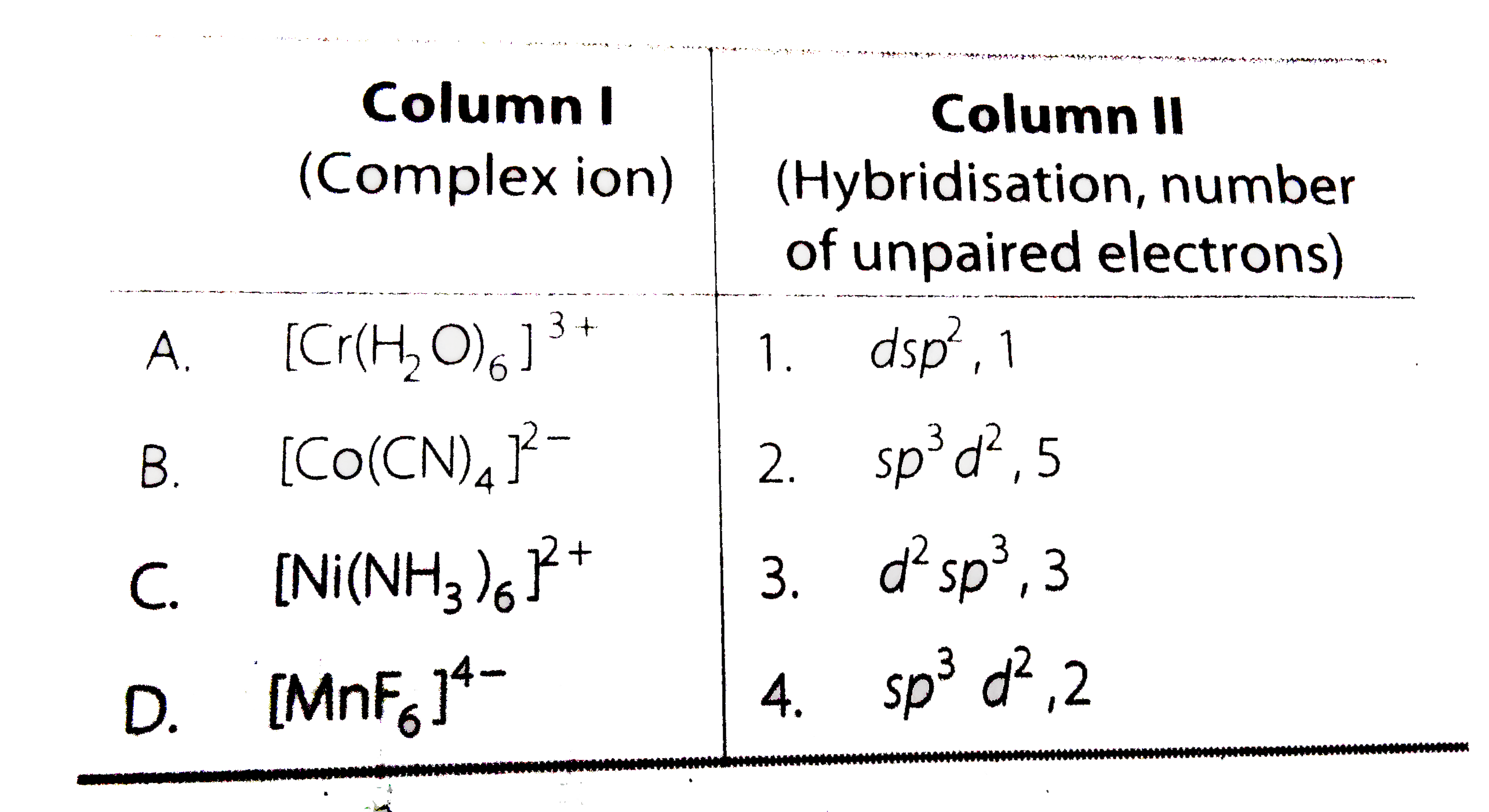Match the complex species given in Column I with the possible isomerism given in Column II and assign the correct code :
Column I (Complex species)Column II (Isomerism)A.[Co(NH3)4Cl2]+1.opticalB.cis−[Co(en)2Cl2]+2.ionisationC.[Co(NH3)5(NO2)]Cl23.coordinationD.[Co(NH3)6][Cr(CN)6]4.geometrical5.linkage
A (1)B (2)C (4)D (5)
A (4)B (3)C (2)D (1)
A (4)B (1)C (5)D (3)
A (4)B (1)C (2)D (3)
The correct Answer is:d
To solve the problem of matching the complex species in Column I with the possible isomerism in Column II, we will analyze each complex species and determine the type of isomerism it can exhibit.
1. Identify Complex A: (Co(NH₃)₄Cl₂)⁺
- This complex has 4 ammonia (NH₃) ligands and 2 chloride (Cl) ligands.
- Since it has different types of ligands, it can exhibit geometrical isomerism (cis-trans).
- Conclusion: A = 4 (Geometrical isomerism)
2. Identify Complex B: cis-(Co(en)₂Cl₂)⁺
- This complex has 2 ethylenediamine (en) ligands and 2 chloride (Cl) ligands.
- The cis form can be optically active due to the lack of a plane of symmetry, while the trans form would be optically inactive.
- Conclusion: B = 1 (Optical isomerism)
3. Identify Complex C: (Co(NH₃)₅(NO₂))Cl₂
- This complex has 5 ammonia (NH₃) ligands and 1 nitrito (NO₂) ligand, along with 2 chloride ions.
- It can exhibit ionization isomerism because when it dissociates, the nitrito ligand can be part of the coordination sphere or outside of it.
- Conclusion: C = 2 (Ionization isomerism)
4. Identify Complex D: (Co(NH₃)₆)(Cr(CN)₆)
- This complex consists of two different coordination spheres: one with cobalt and one with chromium.
- It can exhibit coordination isomerism because the ligands can be exchanged between the two metal centers.
- Conclusion: D = 5 (Coordination isomerism)
Final Matching:
- A = 4 (Geometrical isomerism)
- B = 1 (Optical isomerism)
- C = 2 (Ionization isomerism)
- D = 5 (Coordination isomerism)
Summary of Codes:
- A - 4
- B - 1
- C - 2
- D - 5
- This complex has 4 ammonia (NH₃) ligands and 2 chloride (Cl) ligands.
- Since it has different types of ligands, it can exhibit geometrical isomerism (cis-trans).
- Conclusion: A = 4 (Geometrical isomerism)
- This complex has 2 ethylenediamine (en) ligands and 2 chloride (Cl) ligands.
- The cis form can be optically active due to the lack of a plane of symmetry, while the trans form would be optically inactive.
- Conclusion: B = 1 (Optical isomerism)
- This complex has 5 ammonia (NH₃) ligands and 1 nitrito (NO₂) ligand, along with 2 chloride ions.
- It can exhibit ionization isomerism because when it dissociates, the nitrito ligand can be part of the coordination sphere or outside of it.
- Conclusion: C = 2 (Ionization isomerism)
- This complex consists of two different coordination spheres: one with cobalt and one with chromium.
- It can exhibit coordination isomerism because the ligands can be exchanged between the two metal centers.
- Conclusion: D = 5 (Coordination isomerism)
- A = 4 (Geometrical isomerism)
- B = 1 (Optical isomerism)
- C = 2 (Ionization isomerism)
- D = 5 (Coordination isomerism)
- A - 4
- B - 1
- C - 2
- D - 5
Topper's Solved these Questions
- BOOK - PRADEEPCHAPTER - CORDINATION COMPOUNDSEXERCISE - Assertion And Reason Types Question5videos
CORDINATION COMPOUNDS
- BOOK - PRADEEPCHAPTER - CORDINATION COMPOUNDSEXERCISE - Long Answer Questions7videos
CORDINATION COMPOUNDS
- BOOK - PRADEEPCHAPTER - CORDINATION COMPOUNDSEXERCISE - Short Answer Questions64videos
CORDINATION COMPOUNDS
- BOOK - PRADEEPCHAPTER - CHEMISTRY IN EVERYDAY LIFE EXERCISE - IMPORTANT QUESTION FOR BOARD EXAMINATION30videos
CHEMISTRY IN EVERYDAY LIFE
- BOOK - PRADEEPCHAPTER - D- AND F-BLOCK ELEMENTSEXERCISE - IMPORTANT QUESTIONS30videos
D- AND F-BLOCK ELEMENTS
Similar Questions
Knowledge Check
- Question 1 - Select One
Match the complex ions given in Column I with the colours given the Column II and assign the correct code :
Column I (Complex ion)Column II (Colour)A.[Co(NH3)6]3+1.VioletB.[Ti(H2O)6]3+2.GreenC.[Ni(H2O)6]2+3.Pale blueD.[Ni(H2O)4(en)]2+(aq)4.Yellowish organge5.BlueAA (1)B (2)C (4)D (5)BA (4)B (3)C (2)D (1)CA (3)B (2)C (4)D (1)DA (4)B (1)C (2)D (3) - Question 2 - Select One
Match the compounds given in Column I with the oxidation state of cobalt present in it (given in Column II) and assign the correct code.
Column I (Compound)Column I (Oxidation state of Co)A.[Co(NCS)(NH3)5](SO3)1.+4B.[Co(NH3)4Cl2]SO42.0C.Na4[Co(S2O3)3]3.+1D.[Co2(CO)8]4.+25.+3AA (1)B (2)C (4)D (5)BA (4)B (3)C (2)D (1)CA (5)B (1)C (4)D (2)DA (4)B (1)C (2)D (3) - Question 3 - Select One
Match the complex ions given in column I with the hybridisation and number of unpaired electrons given in column II and assign the correct code
 AA (3)B (1)C (5)D (2)BA (4)B (3)C (2)D (1)CA (3)B (2)C (4)D (1)DA (4)B (1)C (2)D (3)
AA (3)B (1)C (5)D (2)BA (4)B (3)C (2)D (1)CA (3)B (2)C (4)D (1)DA (4)B (1)C (2)D (3)
Match the complen ions given in column 1 with the hybridisation and number of unpaired electrons given in column 2 ad assign the correct code.
Column 1Column 2(A)[CO(NCS)(NH3)5](SO3)(1)+4(B)[Co(NH3)4CI2]SO4(2)0(C)[CO(S2O3)3]Na4(3)+1(D)[CO2(CO)8]((4)+2)(5)+3View SolutionColumn I (Complex)Column II (Magnetic moment)(A)K[Cr(H2O)2(C2O4)2].3H2O(p)1.73BM(B)K4[Mn(CN)6](q)5.92BM(C)[Co(NH3)5Cl]Cl2(r)3.87BM(D)Cs[FeCl4](s)Zero
View Solution[Co(NH3)5NO2]Cl2 and [Co(NH3)5ONO]Cl2 are related to each other as :
View SolutionIn the complex [Co(NH3)5Cl]Cl2, the coordination sphere is
View SolutionMatch the complexed listed column −I with type of hybridisation listed in column −II and select the correct answer using the code given below the lists :
Column−IColumn−II(a)[AuF4]−(p) dsp2hybridisation(b)[Cu(CN)4]3−(q) sp3hybridisation(c)[Co(NH3)6]3+(r) sp3d2hybridisation(d)[Fe(H2O)5NO]2+(s) d2sp3hybridisationView Solution

